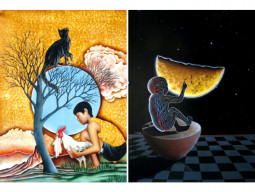
ISLAMABAD:
Often art is construed as being frivolous and accessible to the urban elite only. While art certainly provides a sense of respite from the mundanities of everyday life, it need not have class-based preferences.
The Art Povera (art for the poor) movement was geared towards blurring the line between the aesthetic realm of art and gritty realities during the decade of 60s and 70s across Europe.
“Europe was undergoing a social and political shift. The war had just ended and people were coming back to their normal lives while also dealing with the onslaught of industralisation,” said , art curator Lavinia Fillipi at a session titled “Labyrinth of Reflections”.
She quoted a dichotomy between art and real life. Artists from the lower classes were creating out-of-the-box pieces, using inexpensive materials such as industrial-use bristles, water, fire and paper.
These included the Italian artist Lucioano Fabro whose conceptual art titled “Floor Tautology” was literally pieces of newspaper on the floor, to make the viewer look at the floor with an altered perception.
Quddus Mirza, art critic and moderator of the session, alluded to the risk of an expensive piece of art which no one would be willing to buy from artists belonging to humble backgrounds.
At a book “20 Pakistani painters you should know” launched giants such as Ismail Gulgee, Abdur Rahman Chughtai, Shakir Ali, Jamil Naqsh, RM Naeem, Jimmy Engineer, Anna Molka Ahmed and others have figured in the book.
Moderated by Asif Farrukhi, the panel of speakers comprised Taimur Suri, Tauqeer Mujahir, Tassaduq Sohail and Ali Habib.
Habib read out an excerpt on the painter’s life and his obsession with painting women and girls. Sohail, who went to London to become a writer, soon found himself drawn to the medium of painting. He has over 50,000 paintings to his credit, of which he has not bothered to keep any record. He paints everyday and never repeats a painting.
“I have never painted for money - I’m penniless. I immediately spend whatever I get. I’m most creative when I’m hungry,” said the artist.
“Basically what we set out to do was to depict different styles of Pakistani painters. It talks about the best-known painters rather than the best painters which is subjective. It has no relation with success,” said Farrukhi.
Published in The Express Tribune, April 28th, 2014.


































































COMMENTS
Comments are moderated and generally will be posted if they are on-topic and not abusive.
For more information, please see our Comments FAQ